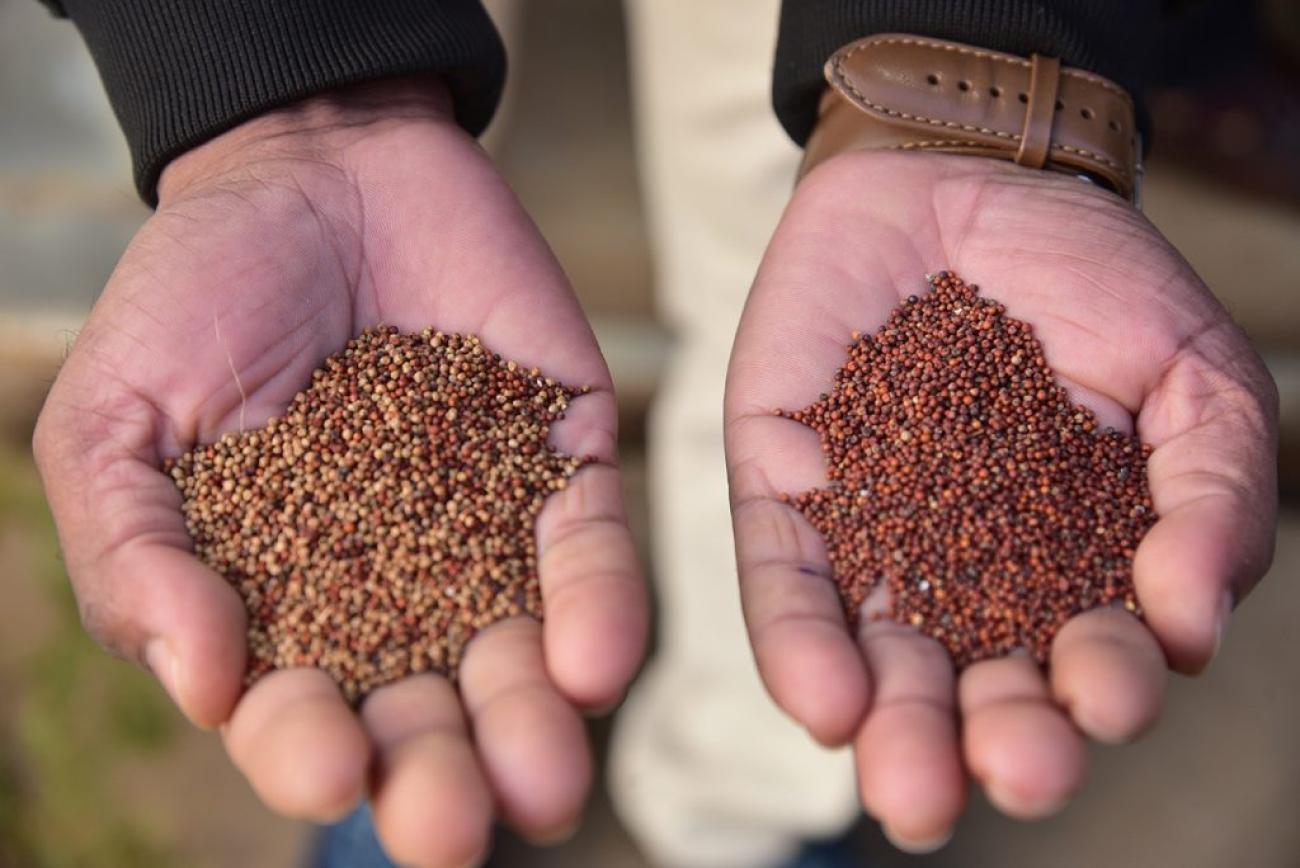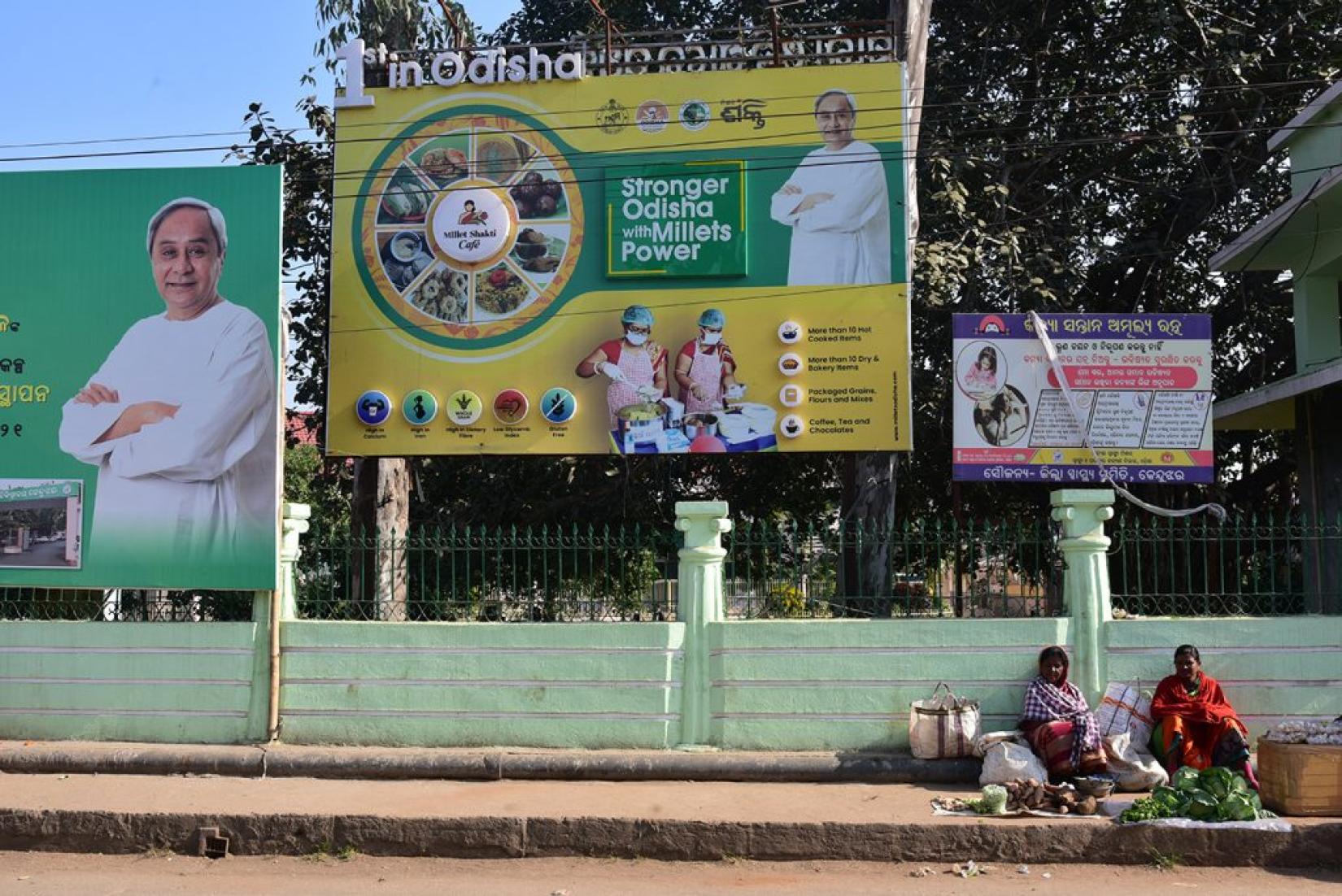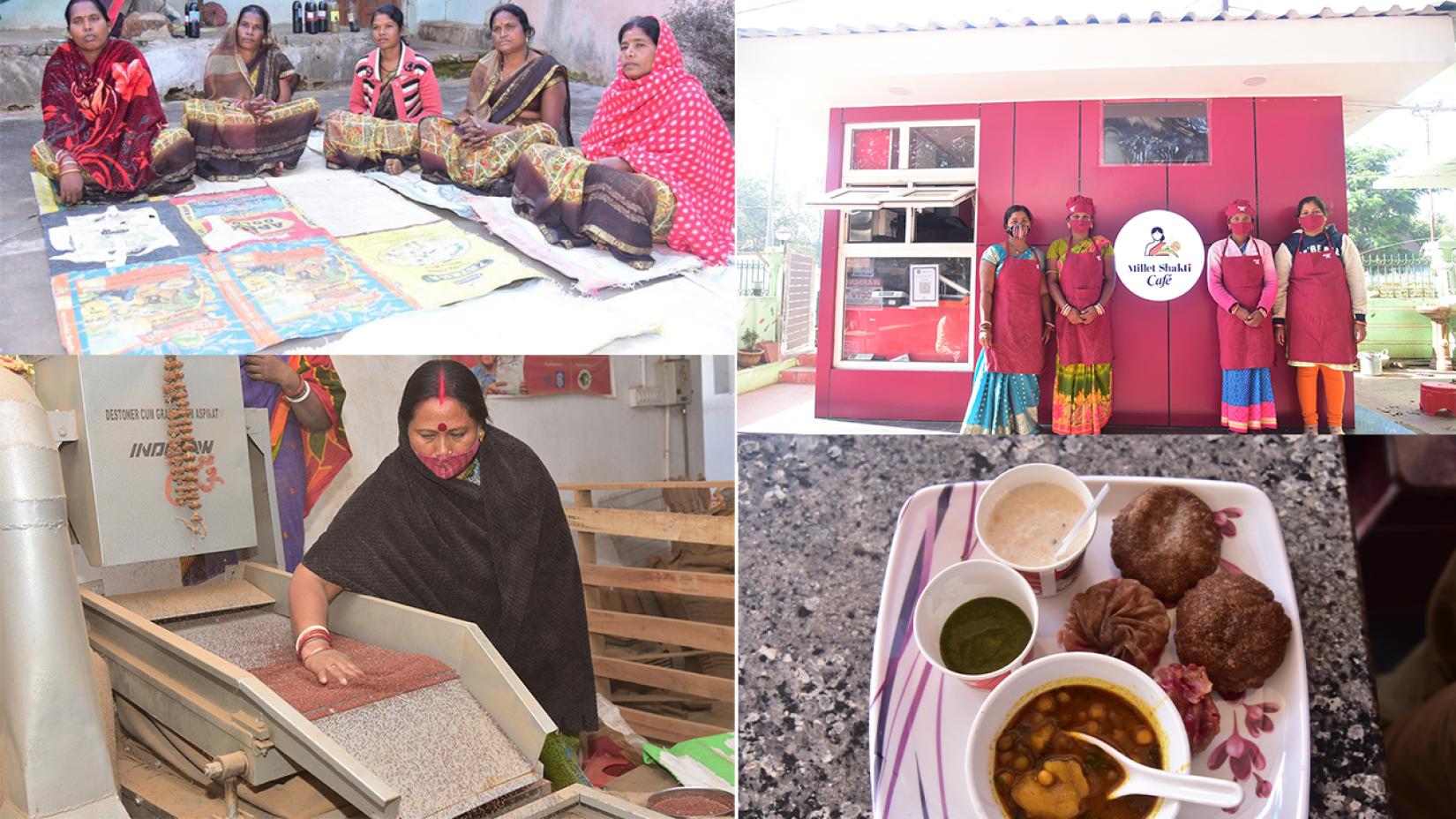Odisha Millets Mission – sowing seeds of change

The World Food Programme and Odisha Government’s Millets Mission are partnering to support small farmers and women by promoting climate resilient crops
Subasa Mohanta, 50, is no stranger to hunger. It was a constant in the lives of this farmer and her family of three (her husband Sureshwar, a son and a daughter). She didn’t know where her next meal would come from even after 16 long hours of back-breaking work as a farmhand and carting stone to a construction site. Then, in 2018, a small bag of seeds — 250 grams to be precise — helped Subasa bid farewell to uncertainties around food and more.
She scattered the finger millet seeds — given to her by the Odisha Government as part of a rural programme — in the fallow land of 0.6 hectares that circles her brick-and-mud house. In about two months, she harvested her first crop of mandia (the Odia word for ragi or finger millet). Subasa sold a part of the about 500 kilograms she harvested at 40 rupees a kilo, kept some of it to feed the hungry mouths at home, and distributed the rest among friends and family. And then she sowed the seeds of change once again on her farmland in the village of Goili in Mayurbhanj district’s Jashipur block.
Over the last three years, Subasa’s story of hope, confidence and empowerment has become intertwined with the genesis and growth of the Odisha Millets Mission (OMM), a flagship programme of the Department of Agriculture and Farmers’ Empowerment, Government of Odisha.
Her days are now divided between farming her own land plus another 3.2 hectares on lease, and advising women in Mayurbhanj and other districts of Odisha on the best practices of millet cultivation. She also attends to local reporters who queue up for a glimpse of Mandia Maa, a moniker she has earned for her hard work and willingness to try a new crop when few others were open to the idea.
The finger millet didn’t just change the fortune of the Mohantas who have now diversified into growing other millets such as suan (little millet) and sorghum. It also made a place for itself in their diet. From mandia kakara pitha (a kind of pancake) to mandia malt (a health drink to start the day with), the family’s bowl of nutrition is also part of the OMM’s journey to success.
Millets in Mission Mode
Launched in 2017, OMM is the first-of-its-kind agricultural initiative that encourages the cultivation of nutrition-rich millets in the eastern Indian state. The objective of the mission goes beyond bringing millets, the traditional food of Odisha’s tribes, back on plates. It aims at strengthening the livelihoods and food security of smallholder farmers by encouraging them to adopt the climate-resilient crop and, at the same time, by creating demand and distributing it through the Public Distribution System (PDS) and the Integrated Child Development Services (ICDS). It hopes to turn it into a tool for tackling malnutrition, alongside other ongoing efforts, especially among vulnerable tribal communities.

A systematic review has shown that a millets-based diet can lead to a significant improvement in the growth of children when compared to a rice-based diet. In addition to providing nutritional security, the OMM also underscores the fact that regular consumption of millets reduces the risk of diabetes, heart diseases and digestion-related disorders while improving respiratory health and the muscular and neural systems.
The millet plant’s high tolerance of heat (up to 64 degrees Celsius), drought and flood also makes the crop an obvious choice for the farmer in an era of climate change and depleting natural resources. They require less water than rice and wheat, the two staples of the Indian diet. The short-season millets grow easily without fertilisers, making them a healthier and safer option for both the consumer and the soil. Under the OMM, as stated in a report by the United Nations World Food Programme (WFP), “only bio-inputs are used and therefore organic millets are being produced. This has led to improved soil quality.” The intercropping of millets with other crops is also beneficial for soil quality. It helps keep a check on water run-off and aids soil conservation in erosion-prone areas.
In 2019, according to WFP, which is partnering with the Government of Odisha on OMM, the administrations of the districts of Gajapati, Koraput and Kandhamal gave one kilo of millets (to be given once a year) to all those holding ration cards under PDS, a programme that supplies subsidised food to the poor. The following year, seven sample districts in the state distributed millets (1-2 kg per annum) to ration-card holders. WFP, which signed an MoU regarding OMM with the Government of Odisha in March 2021, also reports that millets may soon be included in the Mid-Day Meal Scheme under which school students in the districts of Sundargarh and Keonjhar will be given millet biscuits and malt.
At the time of the launch, OMM covered 72 blocks with a sizeable tribal population across 14 districts. In four years, its reach has extended to 84 blocks across 15 districts, 1,510 gram panchayats, 15,608 villages and 1,10,448 farmers. The area under cultivation of ragi in OMM districts has increased from 3,116 hectare to 43,993 hectare since the programme began. Simultaneously the yield of ragi had increased from 13.59 quintals/Ha in 2018 to 16.42 quintals/Ha in 2020.
In a huge confidence boost to the mission, the United Nations General Assembly in 2021 adopted a resolution sponsored by India, declaring 2023 as the International Year of Millets. This follows the inking of an Memorandum of Understanding between WFP and the Government of Odisha to work towards empowering women through OMM and creating global and regional dialogues around millets as a crop that can tackle climate change. Among the suggestions for a national policy on millets, WFP recommends the organic certification of millets so that farmers receive fair market prices, universalisation of a minimum support price (MSP) for all kinds of millets and providing an integrated infrastructure for the entire millet value chain in one location by facilitating establishment of a millet-centred industrial park that includes all upstream and downstream industrial units for end-to-end processing, value addition and packaging.
“WFP is excited about partnering on a compendium of good practices on mainstream millets in India. This exercise will spur millet mainstreaming by knowledge sharing and engagement with state Governments for scale-up in the coming years,” says Bishow Parajuli, WFP Representative and Country Director in India.
“Apart from being a rich source of nutrients and a climate-resilient crop, millet can diversify the food system, support in resilience building and adaptation and enhance livelihoods for small farmers, including women, nationally and regionally,” Parajuli adds.
Women to the fore
In Odisha, what began four years ago with the handing out of leaflets, loudspeaker announcements from vans and seed distribution among villagers by volunteers, community resource persons and officials of the agriculture department has now blossomed into a movement driven by women self-help groups (SHGs). Women, who are still seen as mostly post-harvest labour and keepers of seeds, have taken the lead in ragi processing, improving yields of millets with bio-inputs, and also running cafes and centres that serve millet-based dishes. The humble jau (a porridge made with unpolished grain) — the most common form of millet consumption in Odisha — now enjoys the company of other traditional dishes such as bara, malpua, khaja and chakuli.
About 90 minutes from Jashipur, in the town of Keonjhar Sadar, Ganga Singh of the Krishna Self-Help Group spends four to five hours a day at a workshop processing ragi. In her free time after finishing household work, she thinks up recipes that she can serve the next time she puts up a stall at a training workshop or fair organised under the OMM. So far she has come up with ragi momos, ragi chicken pakoras and ragi biryani. She is also confident that her ragi tea tastes just as good as any hot beverage from a regular food and beverages outlet.
It is perhaps this inventive streak in women — and their openness to new ideas — that inspired the Odisha Government to bring OMM and Mission Shakti, its programme to empower women through SHGs, together in the form of the Millet Shakti Cafe. The first one opened in October 2021 on the premises of the Collectorate in Keonjhar. From ragi and bajra sweets and savouries to flour mixes and bread as take-home items, these cafes, run by local SHGs, are trying to edge refined flour and processed sugar out of food menus. In the process, Millet Shakti is also motivating the homemaker to leave the hearth behind for a few hours of the day for a role that gives her an apron, a chef hat and, most important of all, an income.

The frying pan — or the cookie cutter for that matter — is not the only crucible of change in this story of empowerment. Earthen pots, storage drums and bottles, too, are taking the mission forward. The 10 members of Jashipur block’s Maa Hingula SHG gather at a small workshop every day with loads of leaves of neem and karanja trees, cow dung and urine, jaggery and sand from termite hills. When they finish their work with the ingredients, the bio-inputs (with names such as Jibamruta which means nectar of life, Agnyastra, the weapon of fire, and Handi Khata or pot manure) go out to the market in bottles. These concoctions help agricultural soil fight pests while retaining water and structure.
The seeds of change have taken root, but the way ahead is not free of challenges.
According to agriculture officers and district coordinators on the field, the perception of millets as a food of the poor and the underprivileged is something that needs to be tackled through promotions, social media campaigns, possibly a brand ambassador and awareness messages from celebrities. Some of them see immense potential in tying the OMM with a prestigious platform such as the FIH Hockey World Cup in 2023 which is to be held in Odisha. However, others — for example, representatives of Watershed Support Services and Activities Network (WASSAN), which is the implementation agency of the OMM — feel that stakeholders need to pay more attention to increasing the yield of millets in the state by modernising equipment and encouraging private industries to invest in the crop and its products. Also, the focus needs to expand beyond mandia, which is just one of the nine varieties or so available in India.
Suresh Kumar Vashishth, commissioner-cum-secretary to the Department of Agriculture and Farmers’ Empowerment, Government of Odisha, is hopeful that OMM will rise above the challenges and become an example to the other states in the country. “The mission was started with the idea of increasing consumption, not production. We knew if we could increase consumption at the household level, it would lead to a demand for millets and people would grow millets.”
Vashishth points out that the yield per hectare has doubled. “The area that was shrinking pre-2017 has also started increasing. The farmer’s income has also increased,” he says. Going forward, he adds, OMM needs the support of the urban consumer to find its rightful place on the shelf.
While that shift may be a few summers away, the women in Odisha’s villages and small towns are going about their millet work in full earnest. And lives are changing, grain by grain.
Millets on Wheels: A mobile mission
Every morning, the market in Jashipur, a town in Odisha’s Mayurbhanj district, is a scene of frenetic activity. Amid vendors jostling for space, attention and business is a red-and-yellow mini truck, parked in one corner, with baskets of hot snacks ready to lure the hungry and the adventurous to its counter. Millets on Wheels, a food truck that was inaugurated in June 2020, is a delectable extension of the Odisha Millets Mission (OMM). Managed by the Jashipur Farmers Producer Company Limited (JFPCL), the mobile food kiosk made a comeback in mid-2021 after the Covid-19 pandemic forced it to shut shop following three months of operation. Since then, hot ragi pooris with ghugni, ragi malpua, ragi samosas, ragi pitha and ragi alu chop (potato croquettes) have been the market-goer’s favourite breakfast items. Ragi chowmein may soon make it to the list of offerings.
Ragi laddus in Keonjhar: Bringing millets home
One of the objectives of the Odisha Millets Mission (OMM) is to build momentum for major programmes such as the Mid-Day Meal Scheme and Integrated Child Development Scheme (ICDS) – which provide nutritional meals to pre-school and school students – to include healthy millets in their regular fare. The Keonjhar district authorities have integrated millets in the diet of children in the form of ragi laddus, through a scheme launched in July 2020. After a six-month pilot in the Sadar block, the scheme, as part of the larger ICDS programme, is now available to 87,500 pre-school children through 3,257 anganwadis. The ragi that goes into the making of these nutritious laddus is processed at a unit in Keonjhar town, run by 10 women of the Krishna Self-Help Group (SHG). From there, the millet is transported to other SHGs across four blocks.
The SHG workers prepare the mix by adding groundnut, white sesame, sugar and cardamom to the millet. Then, in foil packs, a mix of 160 grams is delivered to the beneficiaries by anganwadi workers. According to guidelines, each pack should be enough to make eight laddus, which a child should consume over four weeks. But the children’s mothers say the tasty snack is often over within the first week. The success and the effectiveness of the Keonjhar ragi laddu scheme, especially during the pandemic, have inspired the Sundargarh administration to launch the project in the district. Other administrations such as Raigarh in the state of Chhattisgarh have shown an interest in adopting the scheme.
Writer: United Nations / Aditi Sengupta/ Word Wide Media
Photographs: United Nations / Anadi Charan Behera of Studio Priya, Bhubaneswar













